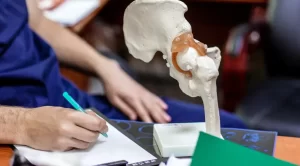Hip pain can be more than just an inconvenience; it can be a sign of underlying joint deterioration that may require a hip replacement. Many individuals find themselves unsure about when it’s time to consider surgery. This article highlights seven key signs that indicate a hip replacement might be necessary, helping you understand when it’s time to seek professional evaluation and what factors influence the decision for surgery. By recognizing these signs early, you can make informed decisions about your joint health.
Sign 1: Persistent Hip Pain That Doesn’t Respond to Rest
Persistent hip pain that doesn’t improve with rest is often an early red flag that the joint itself—not just surrounding muscles—is the root of the problem. Unlike muscular injuries, which typically improve with reduced activity, joint-related pain may remain unchanged or even intensify when you’re inactive. This can be due to degenerative conditions like osteoarthritis, where inflammation and joint damage progress regardless of movement levels. People often misattribute this kind of pain to overuse, but when resting, icing, and stretching don’t make a difference after several weeks, it’s a sign the issue may be structural. This pain often feels deep and aching rather than sharp or surface-level and can fluctuate with weather changes or long periods of immobility. In these cases, advanced imaging may reveal cartilage loss or bone-on-bone friction within the hip socket. Identifying the difference between muscular fatigue and joint deterioration is crucial for timely treatment and long-term joint preservation.
Sign 2: Difficulty Walking or Performing Routine Activities
Struggling to walk or complete everyday tasks is a clear signal that hip joint function is severely compromised. When hip arthritis or degeneration makes it difficult to bend, step, or shift weight, it affects mobility and independence. Routine actions like climbing stairs, standing up from a seated position, or even walking a short distance may become increasingly painful and challenging. These limitations suggest that conservative treatments may no longer be enough and that surgical intervention might be necessary to restore function and alleviate discomfort.
Sign 3: Limited Range of Motion in the Hip Joint
A noticeable reduction in the ability to move your hip joint freely can signal that hip arthritis or joint damage is advancing. Limited range of motion, such as difficulty rotating the hip, bending over, or lifting your leg, directly impacts daily activities like getting in and out of a car, tying shoes, or walking long distances. This restriction can be particularly frustrating for active individuals and may indicate that your hip joint is nearing the point where surgical intervention, like a hip replacement, is the most effective solution.
Sign 4: Chronic Stiffness or Swelling in the Hip Area
Chronic stiffness or swelling in the hip area is often linked to underlying joint inflammation or degeneration. When the hip joint becomes inflamed due to conditions like osteoarthritis, the body may respond with swelling as a natural defense mechanism. This can result in a feeling of tightness, making it difficult to perform everyday tasks such as walking or bending. The swelling can also restrict the movement of surrounding muscles and tendons, intensifying discomfort. In some cases, the body’s immune response may lead to more significant long-term changes in joint function, further complicating mobility. Additionally, overuse or repetitive stress on the hip joint may exacerbate these symptoms, creating a cycle of discomfort and limited movement. Early intervention with treatments such as physical therapy, anti-inflammatory medications, or targeted exercises may help manage stiffness and swelling, while also preventing further deterioration of the joint.
Sign 5: Hip Pain that Worsens at Night
Hip pain that worsens at night is a common complaint, often signaling a deeper issue with the hip joint, like arthritis or a damaged cartilage. When you lie down to sleep, the position can increase pressure on certain parts of the hip, intensifying discomfort. The natural reduction in movement at night can also contribute to stiffness and muscle tightness. In some cases, the body’s inflammatory response may peak at night, leading to increased pain. This pattern is often seen in conditions like osteoarthritis, where the cartilage in the joint wears away over time. As the day ends, the accumulated strain on the hip can become more pronounced, making the pain feel more severe.
Sign 6: Pain that Radiates to the Groin or Thigh
Pain that radiates to the groin or thigh is often dismissed as a pulled muscle or unrelated strain, but in many cases, it signals deep joint dysfunction in the hip. Unlike nerve-related conditions such as sciatica, which tend to travel down the back of the leg, hip-originating pain commonly radiates forward into the groin or down the front of the thigh. This is due to the close anatomical relationship between the hip joint and the femoral nerve, which can become irritated when the joint is inflamed or structurally compromised. This type of referred pain may also worsen when transitioning from sitting to standing or during weight-bearing movements. People frequently report vague discomfort or tightness rather than sharp pain, which can delay proper diagnosis. Paying attention to where the pain travels—and when it flares up—can offer important clues about the health of the hip joint and whether surgical evaluation might be necessary.
Sign 7: When Non-Surgical Treatments Stop Providing Relief
When conservative treatments like physical therapy, medications, or injections no longer alleviate hip pain, it’s a clear sign that the underlying joint damage may be too advanced for non-surgical solutions. While these methods can provide temporary relief, their effectiveness diminishes as the joint continues to deteriorate. If your symptoms persist or worsen despite these efforts, it could be time to consider more permanent options like hip replacement surgery. Prolonged pain despite non-surgical treatments is often a strong indicator that the hip joint’s structural integrity is beyond repair with conservative methods.
Final Thoughts
If you’re experiencing any of these signs, it’s important to take action early and consult with an orthopedic specialist to prevent further damage to your hip joint. Understanding when you need a hip replacement can help you make informed decisions about your health and quality of life. If you’re uncertain or ready to explore your options, visit us at SFHips or call (415) 530-5330 to schedule a consultation. Our team is here to guide you toward the right solution for your hip pain.









